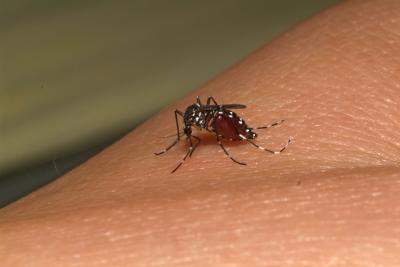Chikungunya poised to invade the Americas

This is Aedes albopictus during a blood-meal. Credit: Institut Pasteur
The risk of a “catastrophic” epidemic in the Americas is boosted by the FIFA World Cup, to be held in Brazil next month, what with people coming in from near and from far, says corresponding author Ricardo Lourenco-de-Oliveira of the Instituto Oswaldo Cruz in Rio de Janeiro, Brazil.
Brazil annually reports the highest incidence of dengue, a virus that is transmitted by Aedes aegypti and Aedes albopictus, the same mosquitoes that transmit chikungunya, he says.
The basis of his worries is the study, in which he and his collaborators compared the ability of 35 populations of the two Aedes species to transmit three different genotypes of chikungunya. These populations ranged all over the Americas from Buenos Aires to Tyson, Missouri (near St. Louis.) Even in temperate Missouri, A. albopictus was found to have a high dissemination and transmission ability for two of the three chikungunya genotypes.
Chikungunya can cause severe joint pain, which can sometimes lead to permanent disability, according to the US Centers for Disease Control and Prevention. Mortality has been known to reach 1/1000. The virus' name reflects the condition of many of the stricken, “bent down or become contorted,” in the Tanzanian Makonda language.
Transmission of chikungunya was first reported in the Americas in December of last year, on the Caribbean island of St. Martin. By February 5th, the disease had spread to nine additional Caribbean countries. “The danger of chikungunya virus spreading all over the tropical, subtropical, and even temperate regions of the Americas is a risk greater than ever,” says Lourenco-de-Oliveira.
“Our results showed that the [Americas are] very receptive and vulnerable to CHIKV [chikungunya virus] transmission, and extremely exposed to the occurrence of an immediate chikungunya epidemic, since most regions are highly infested with both vectors.”
The manuscript can be found online at http://bit.ly/asmtip0414a. The final version of the article is scheduled for the June 2014 issue of the Journal of Virology.
Journal of Virology is a publication of the American Society for Microbiology (ASM). The ASM is the largest single life science society, composed of over 39,000 scientists and health professionals. Its mission is to advance the microbiological sciences as a vehicle for understanding life processes and to apply and communicate this knowledge for the improvement of health and environmental and economic well-being worldwide.
Media Contact
More Information:
http://www.asmusa.orgAll latest news from the category: Health and Medicine
This subject area encompasses research and studies in the field of human medicine.
Among the wide-ranging list of topics covered here are anesthesiology, anatomy, surgery, human genetics, hygiene and environmental medicine, internal medicine, neurology, pharmacology, physiology, urology and dental medicine.
Newest articles

A universal framework for spatial biology
SpatialData is a freely accessible tool to unify and integrate data from different omics technologies accounting for spatial information, which can provide holistic insights into health and disease. Biological processes…

How complex biological processes arise
A $20 million grant from the U.S. National Science Foundation (NSF) will support the establishment and operation of the National Synthesis Center for Emergence in the Molecular and Cellular Sciences (NCEMS) at…

Airborne single-photon lidar system achieves high-resolution 3D imaging
Compact, low-power system opens doors for photon-efficient drone and satellite-based environmental monitoring and mapping. Researchers have developed a compact and lightweight single-photon airborne lidar system that can acquire high-resolution 3D…





















